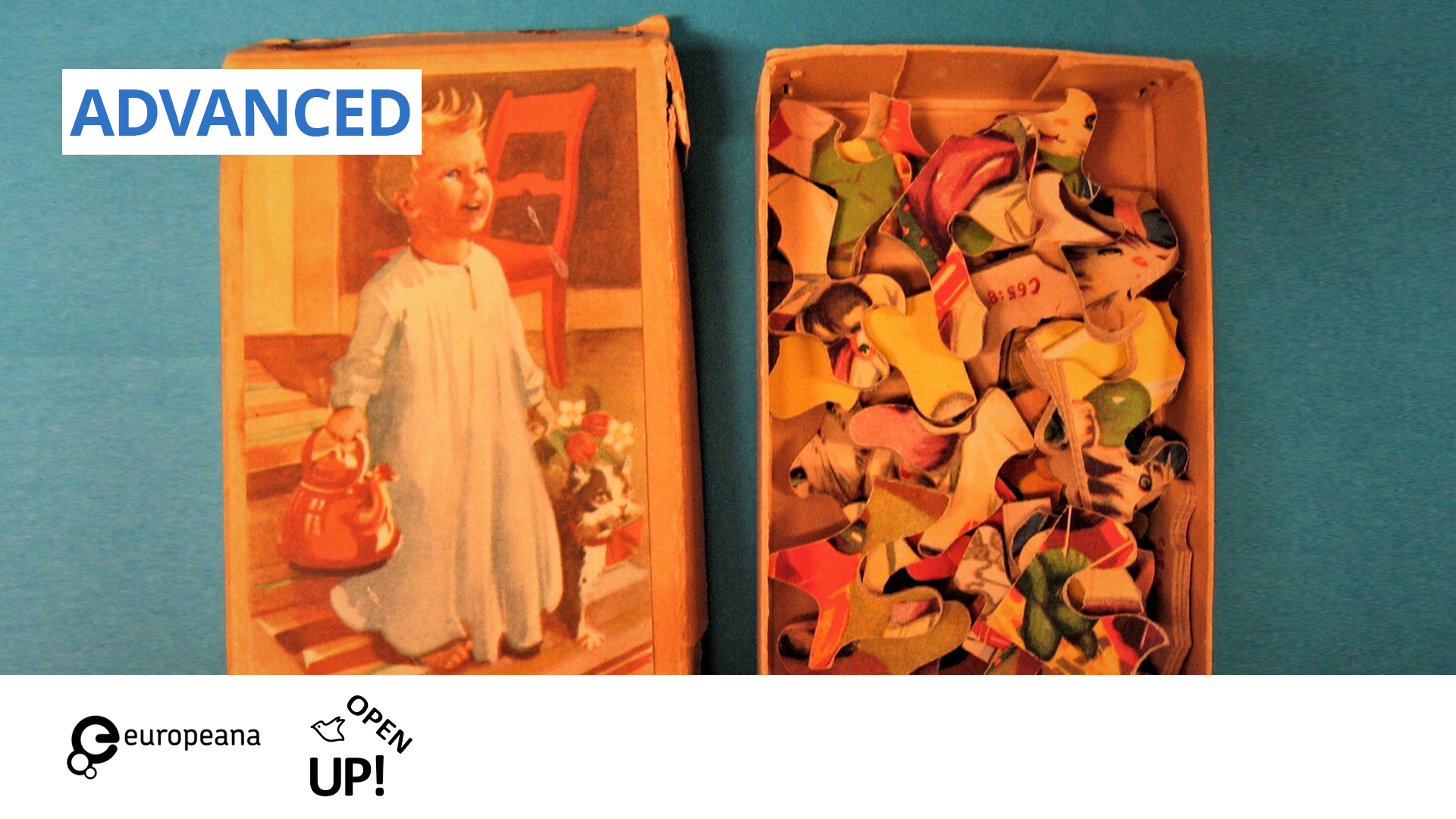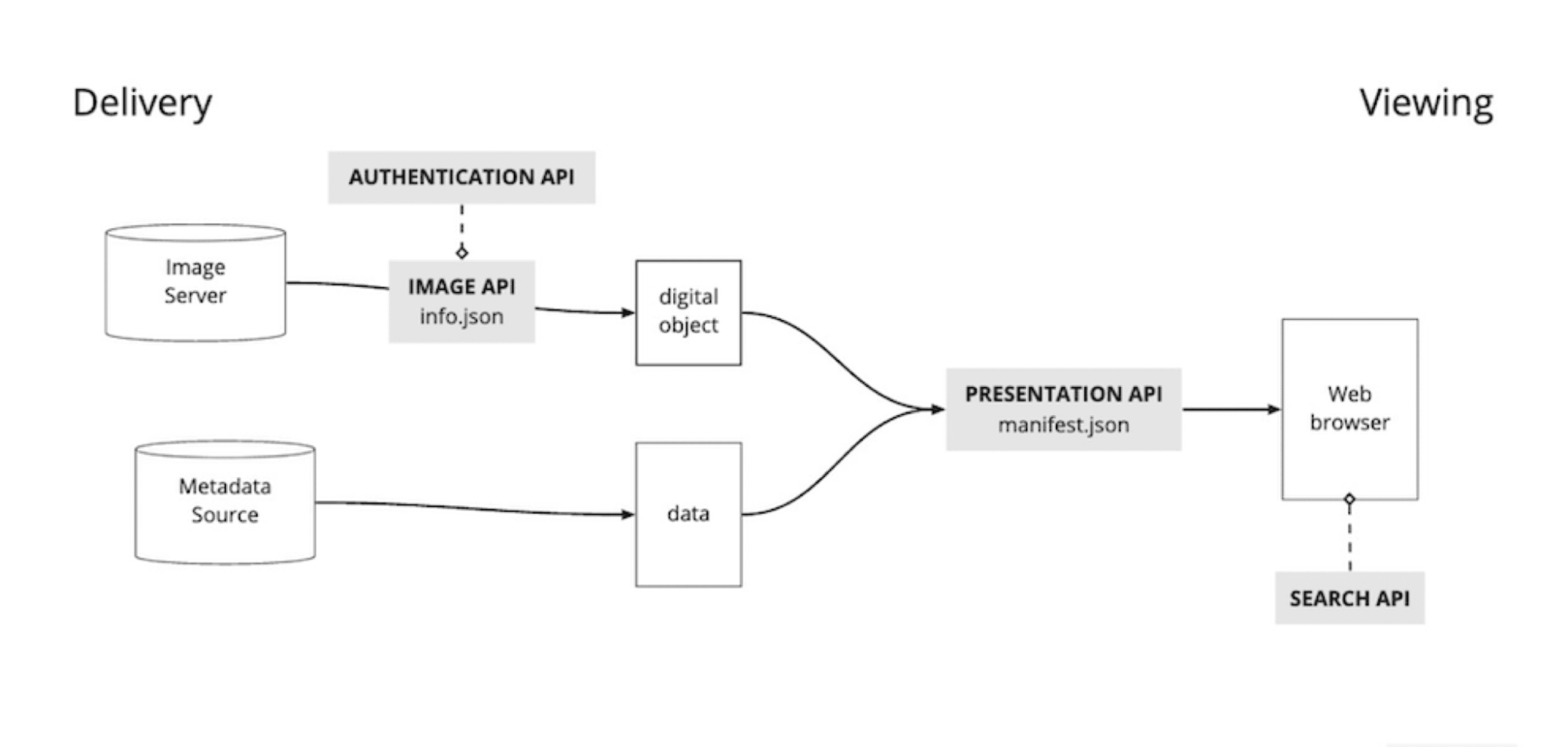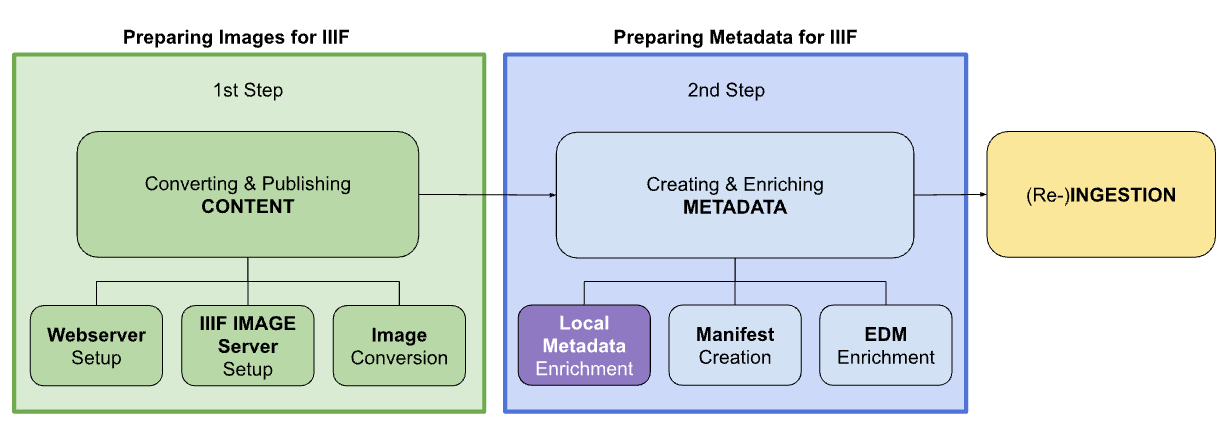Maja Bartl
Maja is a metadata specialist at OpenUp! the natural history aggregator for Europeana.


The International Image Interoperability Framework (IIIF for short) was developed to provide high-resolution and zoomable digital images with consistent metadata and thus make them freely accessible. Via open APIs, digital copies are no longer displayed in local applications, but are shared “barrier-free” on the Internet. This makes IIIF also an important standard for Europeana and the European Data Space for Cultural Heritage.
However, optimal use of the IIIF standard in image repositories requires the presence of a specific system environment and an appropriate image format.
This means that the initial start consists of preparing the image content to be IIIF-compliant (green part of the graphic below). If you afterwards want to provide IIIF images to portals like Europeana, you also need to update and create metadata that is IIIF-compliant in a subsequent process (blue part of the graphic below).

This training course will guide you through the first step of “Preparing Images for IIIF”.
This is an advanced course for which basic technical knowledge is required. Make sure to understand everything in the ‘Requirements’ section or have a technician at your side to assist you if necessary.
The target audience for this training includes, on the one hand, content providers with image repositories who intend to use the IIIF framework and, on the other hand, Europeana aggregators who may wish to support their content providers in the process of adapting to IIIF. You will learn how to convert large quantities of images into an IIIF-compliant format and expose them on an IIIF-compliant image server. The workflow presented in this course is an institutional workflow and as that, one of many. The used software was an individual choice and is surely not exclusive. With the right knowledge you are able to make changes to the shell scripts created by OpenUp! and thus install a web and image server of your choice (this course works with Apache and IIP).
Note for Europeana Aggregators: This course gives you an overview of the technical requirements for converting existing image databases into the IIIF format and installing an IIIF server. The course also provides you with scripts to perform the image conversion and to install an IIIF image server, in this particular case the IIP Image Server. You can either use this knowledge for your aggregation infrastructure (if you host images) or you can pass this course and the information it contains on to the technical contacts of your content providers.
A major benefit of providing your images in IIIF format is the improved online zooming capability through a mechanism called “tiling.” This zoom feature is enabled by multi-resolution images in TIFF or JPEG2000 format. For later reuse, these images must be accessible online via a web server and a IIIF-compliant image server.
With the IIIF image conversion process, your images are given a new internet storage location on a IIIF image server, which you can reuse for future data exports. Please check how you can update your cataloging system with the new image links. Perhaps this is possible as an automated batch update? (A batch file is a script file in DOS, OS/2 and Microsoft Windows. It consists of a series of commands to be executed.)
This course walks you through a proven workflow for setting up a (Apache) web server and a selected IIIF image server (the IIP Server). And it shows how you can automatically convert large amounts of images to multi-resolution TIFF format.
By completing this course you will be able to:
For this training you will need:
To attend this course, you should have the following technical knowledge:
It is of course possible to attend the course purely for information purposes and not carry out the built-in exercises.
This course makes use of 2 shell scripts, which you can find in this github repository. Download and save them according to the instructions in this course.
To perform the image conversion you need a small set of images to be converted to a multi-resolution format. You can either take your own images or use our test images.
Maja is a metadata specialist at OpenUp! the natural history aggregator for Europeana.
Except where otherwise noted, this training resource is licensed under a Creative Commons Attribution 4.0 International License (CC BY 4.0) by AIT Forschungsges. mbH / Open Up! and the Europeana Foundation. Content indicated as being under a different license or still under copyright is included with permission and is not covered by the CC BY 4.0 license.
This training is right for you, if you:
The best quality of a IIIF experience is achieved if the image format supports “tiling”. This works with JPEG2000 and a special form of TIFFs, the pyramid TIFFs. Pyramid TIFF images have several different “tiles” or “layers” that show the image at different zoom levels. This multi-resolution format allows the image server to enhance zoom options without having to decompress the entire file. It simply jumps to the next higher resolution tile as the zoom goes deeper. In this training we will convert images to TIFF format. In this course we will convert images that have a non TIFF format (.jpeg or .png) to TIFF format.
The server software used in this training was chosen due to easy installation and configuration features. Of course, there exist other possibilities like Nginx (Web Server) and Cantaloupe (Image server). If you have deeper technical knowledge and other preferences, you can easily make changes to the provided training scripts and install a different server environment.
Here you can find different server solutions developed by the IIIF Community.
Converting images to pyramid format usually requires more memory. You have to make sure that enough memory space is available on your system. It is hard to forecast how much space your converted images will need, because it highly depends on the type, quality and size of your original images. But you can take a test image that seems representative for your collection (or set), convert it and compare the size of the original and the TIFF-file. Now you can extrapolate the size of the resulting TIFF-file to the number of the images you want to convert.
N.B. In an institutional use case we converted 6404 images with an original size of 24 GB (high quality and size of images) at full quality (100). After the conversion to uncompressed TIFF-files the images had a storage volume of 333 GB. That represents an increase of 1387 %.
When using JPEG compression at quality 90, the storage volume of the images was 132 GB. This corresponds to a size increase of only 550%. By changing the conversion parameters for TIFF files, different results can be achieved in the volume of the newly converted images. Therefore, users should decide which conversion parameters they want to apply according to their needs. The parameters can be changed in the shell script iiif-image-converter. It is advised to direct follow-up questions to your IT specialist.
You can find additional IIIF information and training materials focused on the Image API here: